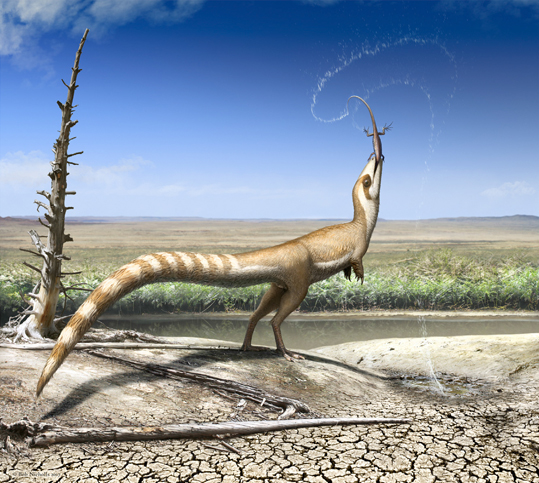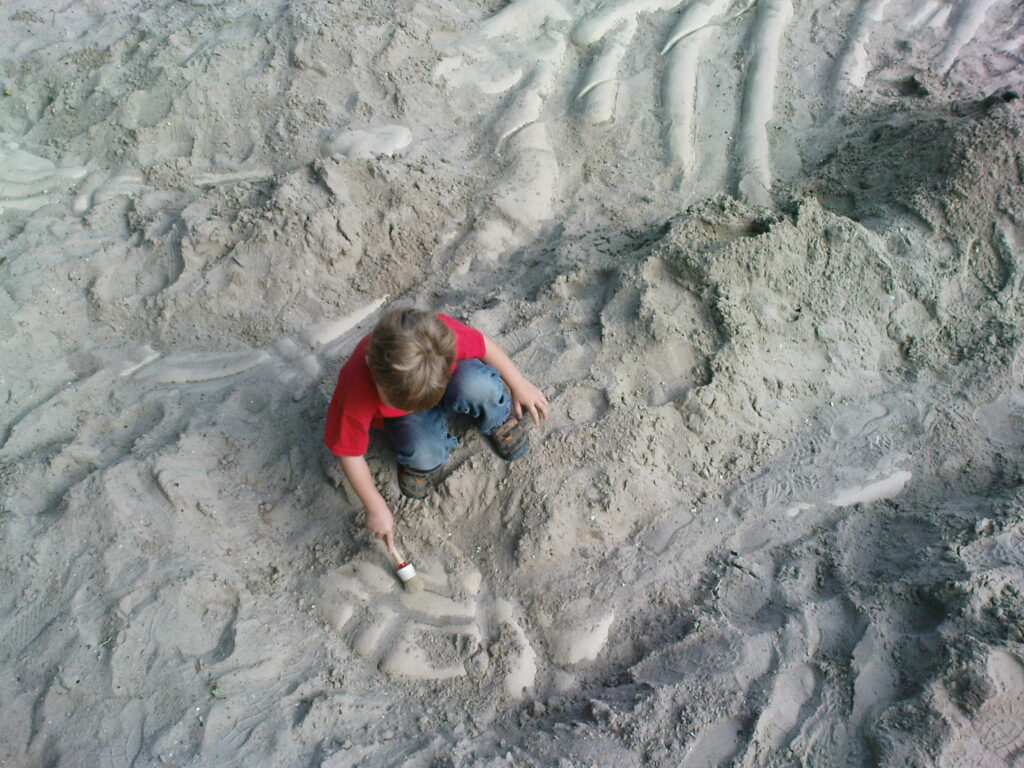Picture this: a massive Carnotaurus standing at the edge of a prehistoric forest, its skin suddenly shifting from dull brown to brilliant crimson as it spots a potential mate across the clearing. While this might sound like something out of a fantasy movie, cutting-edge research suggests that dinosaurs may have possessed one of nature’s most spectacular abilities – the power to change their skin color at will. Recent fossil discoveries and advanced imaging techniques are revolutionizing our understanding of how these ancient giants communicated, courted, and survived in their primordial world.
The Chameleon Connection: Modern Clues to Ancient Mysteries
Today’s chameleons, cephalopods, and various fish species showcase nature’s mastery of color transformation. These creatures use specialized cells called chromatophores, which contain pigments that can be dispersed or concentrated to create stunning visual displays. Scientists have long wondered whether dinosaurs possessed similar abilities. The connection isn’t as far-fetched as it might seem – birds, the direct descendants of dinosaurs, display remarkable color-changing capabilities during mating seasons and territorial disputes. Recent paleontological breakthroughs have uncovered fossilized melanosomes – microscopic structures that once held pigments – in dinosaur feathers and skin impressions. These discoveries are painting a completely new picture of prehistoric life, one filled with vibrant colors and dynamic displays.
Borealopelta: The Armored Rainbow That Rewrote History

In 2017, researchers made a groundbreaking discovery that sent shockwaves through the paleontology community. Borealopelta markmitchelli, a heavily armored dinosaur from 110 million years ago, retained enough of its original coloration for scientists to reconstruct its appearance. This remarkable specimen revealed a sophisticated color pattern: reddish-brown on top with a lighter underside. But here’s where it gets truly fascinating – the pigment distribution suggested this wasn’t just random coloration but a carefully evolved camouflage system. The implications were staggering. If a dinosaur weighing nearly 3,000 pounds needed elaborate camouflage to hide from predators, what kind of monsters were stalking the Cretaceous landscape? More importantly, if dinosaurs could develop such complex color patterns, could they have controlled them dynamically?
Sinosauropteryx: The Striped Sensation That Started It All

Before Borealopelta made headlines, another dinosaur was quietly revolutionizing our understanding of prehistoric color. Sinosauropteryx, a small feathered dinosaur from China, became the first dinosaur whose color pattern was scientifically determined. This chicken-sized predator sported distinctive reddish-brown and white stripes along its tail and back. The pattern wasn’t just decorative – it served as effective camouflage in the dappled sunlight of Cretaceous forests. What makes Sinosauropteryx particularly intriguing is the preserved melanosomes in its feathers. These microscopic structures were so well-preserved that scientists could determine not just the colors, but potentially the mechanisms behind them. The discovery opened up entirely new avenues of research into dinosaur behavior and communication.
The Science Behind the Spectacle: How Color-Changing Actually Works

Color-changing in modern animals relies on several sophisticated biological mechanisms. Chromatophores contain different types of pigments – melanin for blacks and browns, carotenoids for reds and yellows, and iridophores for metallic sheens and blues. These cells can rapidly alter their appearance through muscle contractions, hormonal signals, or neural impulses. A chameleon can shift from green to brown in seconds, while cuttlefish create moving waves of color across their bodies like living neon signs. The key question for dinosaur researchers is whether similar cellular structures could have existed 100 million years ago. Recent studies of fossilized skin impressions suggest that some dinosaurs may have possessed the necessary anatomical foundations for dynamic color change.
Feathered Flirtation: When Dinosaurs Dressed to Impress

Modern birds provide our best window into how dinosaurs might have used color for courtship. Male peacocks, birds of paradise, and mallard ducks transform into living rainbows during mating season, using every trick in nature’s palette to attract females. Evidence suggests that feathered dinosaurs like Anchiornis and Microraptor possessed similar capabilities. Anchiornis, in particular, displayed a striking black body with white-striped wings – a color scheme that would have been impossible to maintain without sophisticated pigment control mechanisms. The evolutionary pressure to stand out during mating season could have driven the development of increasingly elaborate color displays. Imagine a Cretaceous courtship ritual where potential mates literally lit up like Christmas trees, their skin and feathers shimmering through spectrum of colors to demonstrate their genetic fitness.
Predator and Prey: The Deadly Game of Hide and Seek

Color-changing abilities would have provided enormous advantages in the brutal world of dinosaur survival. Predators could have used rapid color shifts to become nearly invisible while stalking prey, much like modern tigers use their stripes to blend into tall grass. Herbivorous dinosaurs might have developed defensive color displays – sudden flashes of bright warning colors to startle attackers, similar to how modern frilled lizards use their colorful neck displays. The ability to quickly shift from camouflage to warning colors could mean the difference between life and death. Some researchers theorize that pack-hunting dinosaurs like Deinonychus could have used coordinated color displays to communicate during hunts. Imagine a group of raptors silently coordinating their attack through subtle shifts in skin tone – a prehistoric version of military hand signals.
Fossil Evidence: Reading the Rainbow in Ancient Rocks

Extracting color information from fossils requires incredibly sophisticated techniques. Scientists use electron microscopy to examine melanosomes at the cellular level, comparing their shape and size to those found in modern animals with known colorations. The process is like being a detective working a 100-million-year-old cold case. Each fossil provides tiny clues – a preserved feather here, a skin impression there – that gradually build into a complete picture of prehistoric life. Recent advances in chemical analysis have allowed researchers to identify not just melanin-based colors, but potentially other pigment types as well. This opens up the possibility of discovering dinosaurs with green, blue, or even iridescent colorations that were previously thought impossible to preserve.
Temperature Control: The Cool Side of Color Change
Color-changing abilities serve more than just social and survival functions – they’re also crucial for temperature regulation. Dark colors absorb more heat while light colors reflect it, allowing animals to fine-tune their body temperature throughout the day. For massive dinosaurs living in the tropical Cretaceous climate, this could have been a matter of life and death. A Brontosaurus might have started the day dark-colored to quickly warm up, then shifted to lighter tones as temperatures rose to prevent overheating. This thermoregulatory function could explain why some of the largest dinosaurs show evidence of complex skin patterns. The bigger the animal, the more critical temperature control becomes, and color-changing skin would have provided an elegant solution to this physiological challenge.
Seasonal Transformations: Dinosaur Fashion Through the Ages
Modern animals often undergo dramatic seasonal color changes – arctic foxes turn white in winter, male cardinals become brilliant red during breeding season, and many mammals develop thicker, darker winter coats. Dinosaurs likely experienced similar seasonal transformations. Cretaceous seasons were more extreme than today’s climate, with some regions experiencing dramatic wet and dry periods. Dinosaurs might have adapted their coloration to match changing vegetation patterns, becoming greener during lush growing seasons and browner during dry spells. The discovery of dinosaur nesting sites with preserved eggshells suggests that some species had specific breeding seasons. During these periods, dinosaurs might have undergone spectacular color transformations rivaling anything seen in the modern animal kingdom.
Social Hierarchies: Status Symbols Written in Living Color
In many modern animal societies, color serves as a visual indicator of social status. Dominant males often display the brightest, most intense colors, while subordinate individuals remain relatively dull to avoid confrontation. Dinosaur social structures were likely far more complex than previously imagined. Evidence of herding behavior, cooperative nesting, and even possible tool use suggests sophisticated social interactions that would have required clear communication methods. Color displays could have functioned as prehistoric status symbols – the dinosaur equivalent of expensive jewelry or clothing. A particularly vibrant individual might have signaled their genetic quality, territory ownership, or position within the herd hierarchy through dynamic color patterns.
The Cephalopod Connection: Ancient Intelligence in Technicolor
Modern cephalopods like octopi and cuttlefish represent the pinnacle of color-changing evolution. These creatures can not only change colors instantly but create complex moving patterns across their skin that function almost like a visual language. Some researchers propose that highly intelligent dinosaurs like Troodon might have developed similar capabilities. With brain-to-body ratios comparable to modern birds, these dinosaurs could have possessed the neural complexity necessary for sophisticated color communication. The idea of dinosaurs communicating through dynamic color displays challenges our fundamental assumptions about prehistoric intelligence. Rather than the simple-minded monsters of popular culture, these creatures might have been engaging in complex visual conversations that we’re only beginning to understand.
Environmental Pressures: Evolution’s Artist at Work

The Cretaceous period was a time of rapid environmental change, with fluctuating sea levels, volcanic activity, and shifting climate patterns. These pressures would have driven rapid evolutionary innovation, including the development of advanced color-changing abilities. Dinosaurs living near coastal areas might have needed to adapt quickly to changing environments as sea levels rose and fell. The ability to rapidly alter camouflage patterns would have provided enormous survival advantages in these dynamic ecosystems. Forest fires, seasonal flooding, and other environmental disasters would have created additional selective pressures favoring animals with flexible color adaptation strategies. Over millions of years, these pressures could have produced color-changing abilities that exceeded anything seen in the modern world.
Technology Reveals Ancient Secrets

Modern paleontology is experiencing a technological revolution that’s transforming our understanding of dinosaur biology. Advanced imaging techniques, chemical analysis, and computer modeling are revealing details about prehistoric life that seemed impossible just decades ago. Synchrotron X-ray technology can now peer inside fossilized cells without damaging them, revealing preserved organelles and chemical signatures that hold clues to ancient coloration. These techniques have already revolutionized our understanding of dinosaur feathers and skin. Machine learning algorithms are helping scientists identify patterns in fossil data that human researchers might miss. As these technologies continue to advance, we may soon have detailed color reconstructions of entire dinosaur ecosystems, complete with seasonal variations and behavioral displays.
The Future of Prehistoric Color Research

We’re standing at the threshold of a new era in dinosaur research, where the gray, lifeless creatures of old museum displays are being replaced by vibrant, dynamic animals that rivaled tropical rainforests in their color diversity. Ongoing excavations in fossil-rich regions like China, Mongolia, and South America continue to yield specimens with preserved soft tissues and pigment structures. Each new discovery adds another piece to the puzzle of prehistoric life. The implications extend far beyond simple curiosity about dinosaur appearance. Understanding how these ancient creatures adapted to environmental challenges through color change could provide insights into how modern species might cope with climate change and habitat loss.
Conclusion

The next time you watch a chameleon slowly shift from green to brown, or marvel at a cuttlefish’s hypnotic color display, remember that you might be witnessing an echo of the Cretaceous world. These ancient giants may have possessed abilities that make modern color-changing animals look like amateurs, turning the prehistoric landscape into a living kaleidoscope of evolutionary artistry. What other secrets are hiding in the rocks beneath our feet, waiting to transform our understanding of life on Earth?




